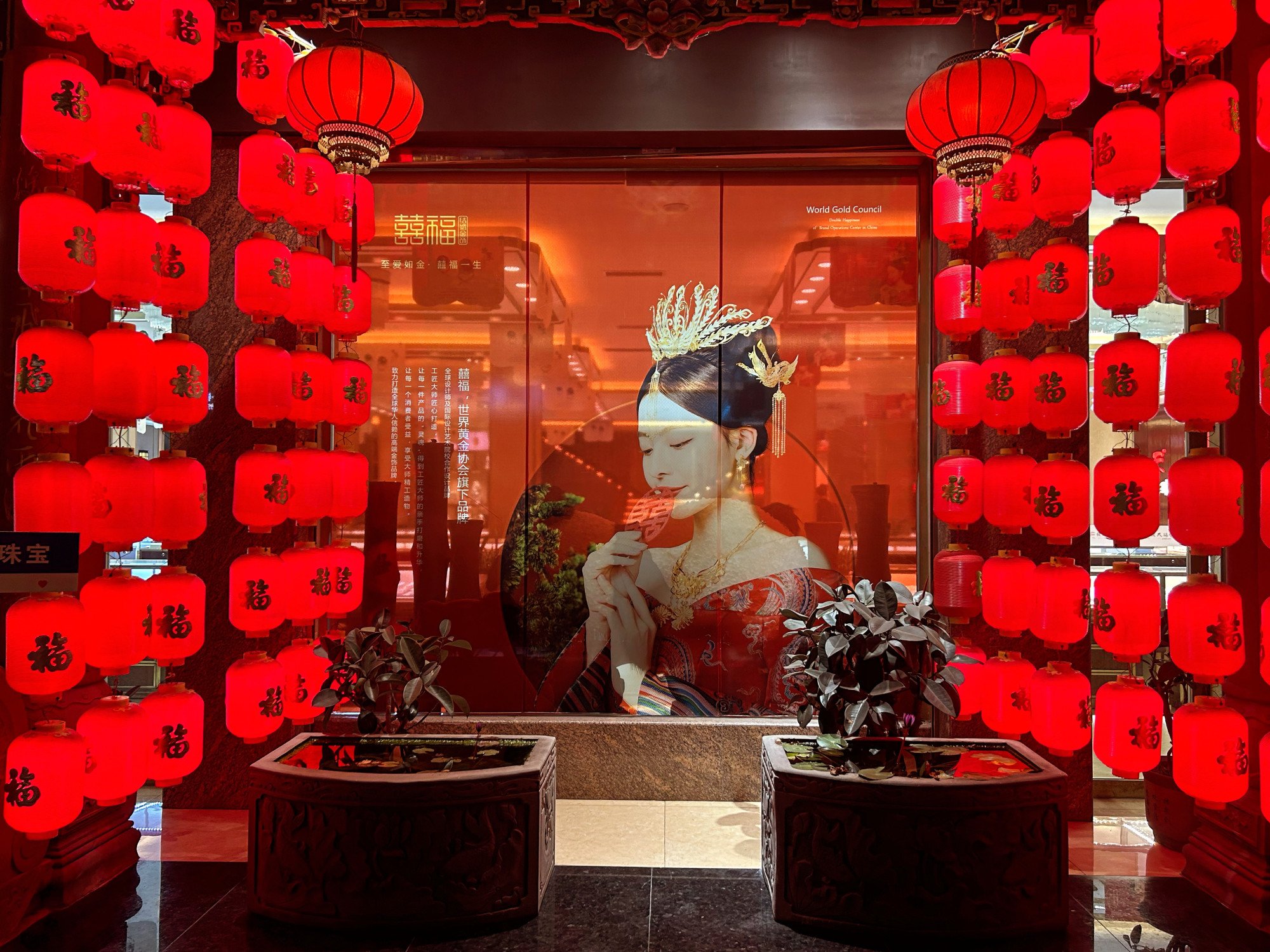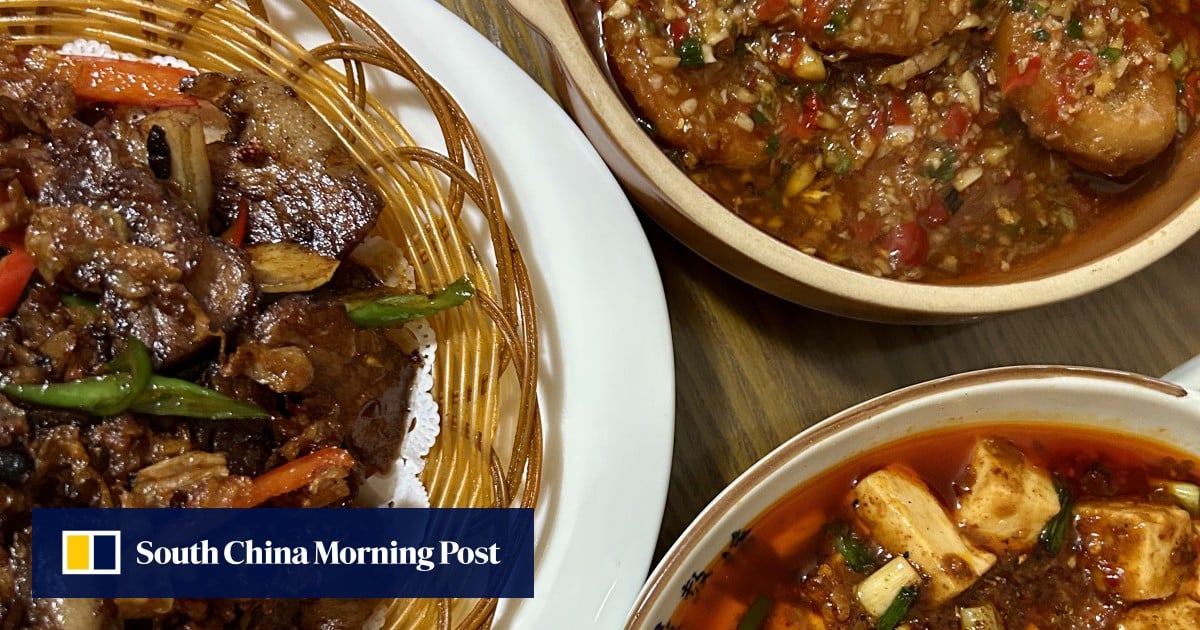The provincial capital is the birthplace of world-famous Sichuan cuisine, and the revered “numbing” pepper, a corn plant containing a molecule called hydroxy-alpha-sanshool that temporarily numbs the lips and tongue.
With wide avenues lined by even-wider footpaths, gleaming skyscrapers, plentiful greenery and parks, this whisper-clean city of 20 million is renowned in China for its more relaxed way of life.
Why Sichuan food is trending and where to eat Hong Kong’s best ‘mala’ dishes
Why Sichuan food is trending and where to eat Hong Kong’s best ‘mala’ dishes
Chengdu also offers remarkable value for money. A Japanese-themed 30 square metre (320 sq ft) hotel room with city views at the Chengdu Flipflop Lounge Hostel, in the trendy downtown Chunxi Road precinct, sets me back just 187 yuan (US$26) per night.
My travel agent, Shang Qin, of Adventure Tour China, invites me to join him for dinner at a hotpot restaurant called Long Sen Yuan (Dragon Forest Garden).
The invitation brings back chilling memories of the hotpot restaurant I visited before leaving Tibet; the hotpot was just a pot of water sitting on an element; the ingredients were big chunky greens and heavily processed meats.

But tonight promises to be different.
Set on Qintai Road, a Qing dynasty-themed tourist precinct lit up by lanterns and ambient lights at night, Long Sen Yuan is listed in the Michelin Guide China as a “no-frills restaurant” with “just one thing on the menu – authentic Chengdu hotpot”.
“Every province in China has its own version but ours is the most famous because we put Sichuan peppers into ours so your lips will be numb.”
Our bubbling hotpot turns ochre from the orgy of herbs and spices added in addition to the Sichuan peppers.

Chengdu is home to Shui Jing Fang, a baijiu factory, museum and exhibition space listed as “the oldest distillery in China”. But that’s just marketing hype.
The real story? When Shui Jing Fang’s owners renovated the premises 25 years ago, they found the ruins of a 600-year-old baijiu factory, and called it their own.
After dinner, Qin takes me to the Sichuan Opera House, on Qintai Road, for a 90-minute extravaganza of dance, music, acrobatics, drama, puppetry and comedy that is so well-produced, so perfectly choreographed and so visually stunning it brings tears to my eyes.
The following day I enlist Lost Plate, a company offering food tours in six Chinese cities, including three in Chengdu, to show me the best of the best food in the city. I opt for the evening food tour by tuk-tuk.

Withdrawn by authorities as a form of transport in Chengdu during a modernisation drive years ago, the last of the city’s tuk-tuks are operated by Lost Plate. The machines are slow and noisy but have space in the back for an ice box full of soft drinks and beer.
“Shanghai food is famous for its sweetness,” says Mungxi, a 26-year-old environmental activist who moonlights as a food guide at night. “Beijing’s food is also famous for something … I don’t know, I have to look it up. But the food in Chengdu is famous for its spice.
“You won’t forget it after you try it.”
Set on the ground floor of a colonial-style terrace with simple wood furniture and rows of framed awards on the walls, the first restaurant Mungxi takes me to specialises in “folded arm”, Sichuan-style pork dumplings served in either a clear broth or in a texture-rich sweet and spicy sauce.
The pastry is thin and melts in the mouth. The minced pork stuffing tastes tellingly home-made. These dumplings are like kisses, and come with an interesting backstory.

“The owner is a housewife,” Mungxi explains. “Her dumplings were so good that she started selling them from her apartment. Everyone went there.
“I remember being in the queue when I was still in school. I don’t think her neighbours liked it. Eventually, she bought this restaurant.
“They open at midday and are usually sold out within a few hours. We have to make reservations so we can bring our customers here at night.”
She adds: “There are lots of copycats, you know? There’s one right next door. They’re not bad. People go there when this place sells out.”

A few old-timers can still be seen doing so in the early mornings but we head to Dan Dan Tian Shui Mian, one of the most famous dandan restaurants in the city.
We order the special, sweetwater noodles bathed in a peanut and chilli oil sauce. The noodles are long and thick, and prepared al dente.
We start with a fragrant dish made with crunchy lotus root, an aquatic vegetable consumed throughout East Asia. The roots are sliced in half like a burger bun, stuffed with minced pork, battered with egg white, fried and finally bathed in a fish sauce.
Next, we dig into hui guo rou, or Sichuan-style twice-cooked pork, one of the most loved of the province’s dishes. The pork belly is first boiled in water with ginger, shallots and cooking wine before being stir-fried with Sichuan peppers, cabbage and capsicum.

Legend has it the dish was invented when the Qianlong Emperor (1711-1799) visited a village without notice. He wanted a feast at every stop he made, but these villagers were worried; their crops had not grown well that year, so they put what was left of their own meals back into the pot and cooked the food again (thus “twice-cooked”) before serving to the emperor.
To their surprise, he enjoyed it.
“To be considered a Sichuanese chef, you have to master this dish,” says Mungxi.
“The numbing peppers,” Mungxi says, “are also a type of traditional Chinese medicine as they are good for your circulation and make you sweat.”

That they do. The peppers also overpower the normally distinct flavour of the tofu and send my mouth half to sleep with every bite. The sensation is strange for the unaccustomed but also addictive.
After every mouthful, I tell myself no more. Yet as soon as the numbing dissipates, I crave another.
I spend the next two days walking around aimlessly and stuffing my face with candied nuts; juicy, giant mandarins; and foot-long pork belly strips that are diced up and served in a paper bowl with lettuce and chilli powder.
But the most memorable thing I eat is a sandwich. Who knew bread was even a thing in China?
“In the south of China we eat a lot of rice but in the north, they eat a lot of bread,” says Anita Lai Shiwen, founder of Chengdu Food Tours, the city’s first food tour company, established in 2016.
“The bread here is called ‘pot helmet’ because of its shape; it’s shaped like pita bread but toasted and crunchy.”

The “here” is Yan Taipo (Great-Granny Yan), a kebab-style takeaway joint set on top of the Wenshu Monastery subway station that nearly always has a queue of hungry customers.
When I arrive, to rendezvous with Lai, there are about 20 people in the queue. The signature sandwich, Lai tells me, is beef but for the more adventurous there’s pig nose and vegetarian options such as bamboo.
The shiny red sauce runs down my hands as I crunch my way through it.
I ask Great-Granny Yan about the secret to a great sandwich.
“Crispy outside but soft inside, so you get a really nice combination,” she says. “And freshness. We bake the bread right here and make the fillings and sauces to order.”
How can we best share our lifestyle with visitors? Through food
Anita Lai Shiwen, founder of Chengdu Food Tours
From there, Lai takes me to another dandan noodle joint, right in front of the Wenshu Monastery; a small restaurant old-timers visit for a snack after paying their respects at the temple.
But after that incredible sandwich the noodles don’t even register in my gustatory cortex – the brain structure responsible for perceptions of taste. I do, however, learn from my guide how Chengdu’s sophisticated food culture came to be.
“Chengdu’s nickname is Land of Abundance,” Lai says. “The city was originally on a floodplain, a basin, surrounded by mountains. People couldn’t really make a living here. But about 2,000 years ago they redirected the water to stop the floods. The land became very fertile and we started to grow pretty much everything.”
Lai is referring to the Dujiangyan irrigation system, an engineering marvel built in 256BC and still in use.
“That gave birth to our laid-back lifestyle – you didn’t have to work non-stop to survive, you don’t see the fast-paced life of Shanghai here. And how can we best share our lifestyle with visitors? Through food.
“So instead of just taking tourists to great restaurants, I am going to take you to see the food raw.”

Like the noisy old tuk-tuks, many wet markets in Chengdu have fallen prey to the city’s modernisation drives and been pushed into sanitised indoor spaces. But not the Qingyang Market, in the neighbourhood of the same name.
Here we spend an hour or more wandering around, visiting the stalls of a pickle maker, a distiller who fills giant glass bottles with different kinds of home-made baijiu, and a mushroom salesman.
From yellow mushrooms used for soup to the bizarre goat stomach mushroom, monkey head mushroom and chicken leg mushroom, he has just the mushroom you are looking for.
We also visit a stall selling varieties of Sichuan pepper.
“Do you know these are not even peppers? Smell one,” says Lai, pinching a small round ball from a pyramid-shaped pile. “It smells like orange because it’s from the citrus family.”
It’s yet another surprise from Chengdu, a city whose army of chefs, cooks, hawkers and food guides have turned my opinion and understanding of Chinese food on its head.
The food was so good, I can still taste it now.






